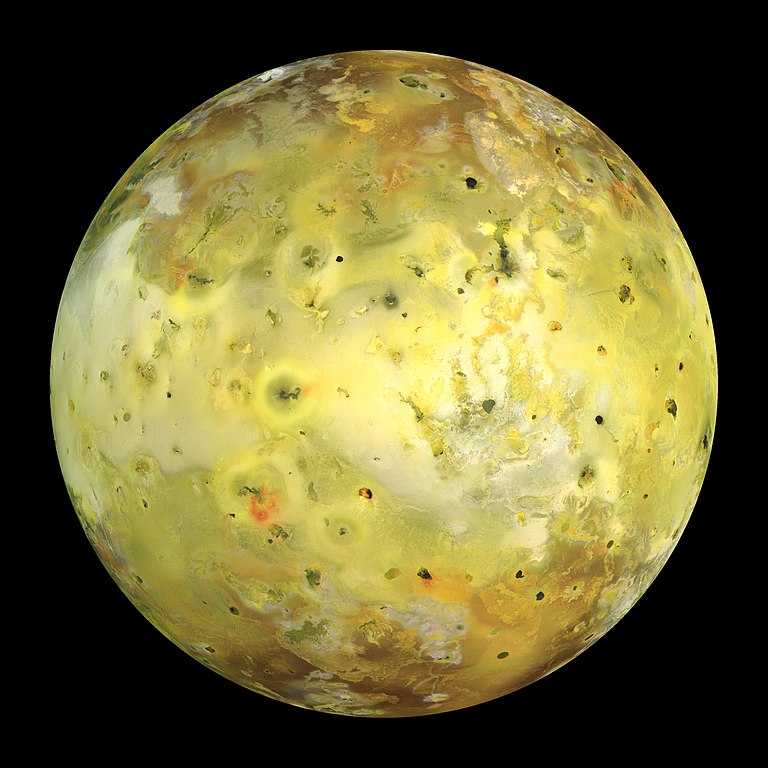
List of facts
Io was discovered in January 1610 by Galileo Galilei, along with the other Galilean satellites.
Io is also known as Jupiter I
Io is the innermost of the four Galilean moons
Io is the third-largest of the four Galilean moons of the planet Jupiter
Io is the fourth-largest moon in the solar system.
Io is one of the few moons to have an atmosphere although it is very thin.
Io’s atmosphere consists mainly of sulfur dioxide, with minor constituents including sulfur monoxide, sodium chloride, and atomic sulfur and oxygen
It is slightly larger than Earth’s moon
Io is the most geologically active object in the Solar System
Io has more than 400 active volcanoes on its surface
Io has a very thin atmosphere that contains mostly sulfur dioxide emitted from its volcanoes
The volcanic plumes of Io rise up as high as 200 km
Io has 100 to 150 mountains
Some of IO’s mountains are as high as Mount Everest.
The average height of Io’s mountains are around 6 km.
Io is 3642.6 km wide
Io is primarily composed of silicate rock surrounding a molten iron or iron-sulfide core.
It takes 42 hours for Io to rotate on its axis.
It also takes 42 hours for Io to complete one orbit around Jupiter.
The 2 previous facts mean that the same side of Io always faces Jupiter
Io comes from Greek mythology where Io was the priestess of Hera – the wife of Zeus.
Io’s surface has a very colorful appearance and that is caused by volcanism that deposits material on its surface.
Io hangs at a mean distance of 421,700 kilometers from Jupiter
Scientists say that 75% of the mantle of Io is made of forsterite – a mineral that is rich in magnesium.
the International Astronomical Union has approved 225 names for Io’s volcanoes, mountains, plateaus, and large albedo features.
Io is the fifth moon out from Jupiter
Io plays a significant role in shaping Jupiter’s magnetic field, acting as an electric generator that can develop 400,000 volts across itself and create an electric current of 3 million amps
The magnetosphere of Jupiter sweeps up gases and dust from Io’s thin atmosphere at a rate of 1 tonne per second
This material is mostly composed of ionized and atomic sulfur, oxygen and chlorine; atomic sodium and potassium; molecular sulfur dioxide and sulfur; and sodium chloride dust
Io orbits within a belt of intense radiation known as the Io plasma torus.
The lithosphere of Io, composed of basalt and sulfur deposited by Io’s extensive volcanism, is between 12 km and 40 km thick
Quick information about Io
| Discovery | |||||||||
|---|---|---|---|---|---|---|---|---|---|
| Discovered by | Galileo Galilei | ||||||||
| Discovery date | 8 January 1610 | ||||||||
| Designations | |||||||||
|
Named after
|
Ἰώ Īō | ||||||||
|
Alternative names
|
Jupiter I | ||||||||
| Adjectives | Ionian | ||||||||
| Orbital characteristics | |||||||||
| Periapsis | 420000 km (0.002807 AU) | ||||||||
| Apoapsis | 423400 km (0.002830 AU) | ||||||||
|
Mean orbit radius
|
421700 km (0.002819 AU) | ||||||||
| Eccentricity | 0.0041 | ||||||||
|
Orbital period (sidereal)
|
1.769137786 d (152853.5047 s, 42.45930686 h) | ||||||||
|
Average orbital speed
|
17.334 km/s | ||||||||
| Inclination | 0.05° (to Jupiter’s equator) 2.213° (to the ecliptic) |
||||||||
| Satellite of | Jupiter | ||||||||
| Group | Galilean moon | ||||||||
| Physical characteristics | |||||||||
| Dimensions | 3,660.0 × 3,637.4 × 3,630.6 km | ||||||||
|
Mean radius
|
1821.6±0.5 km (0.286 Earths) | ||||||||
|
Surface area
|
41910000 km2 (0.082 Earths) | ||||||||
| Volume | 2.53×1010 km3 (0.023 Earths) | ||||||||
| Mass | (8.931938±0.000018)×1022 kg (0.015 Earths) | ||||||||
|
Mean density
|
3.528±0.006 g/cm3 (0.639 Earths) | ||||||||
|
Surface gravity
|
1.796 m/s2 (0.183 g) | ||||||||
|
Moment of inertia factor
|
0.37824±0.00022 | ||||||||
|
Escape velocity
|
2.558 km/s | ||||||||
|
Synodic rotation period
|
synchronous | ||||||||
|
Equatorial rotation velocity
|
271 km/h | ||||||||
| Albedo | 0.63±0.02[6] | ||||||||
|
|||||||||
| Atmosphere | |||||||||
|
Surface pressure
|
0.5 to 4 mPa (4.93×10−9 to 3.95×10−8 atm) | ||||||||
| Composition by volume | 90% sulfur dioxide | ||||||||

2 comments
[…] Have you enjoyed this you can also read about IO – Various facts about Jupiters moon Io […]
[…] Various facts about Jupiters moon Io […]
Comments are closed.